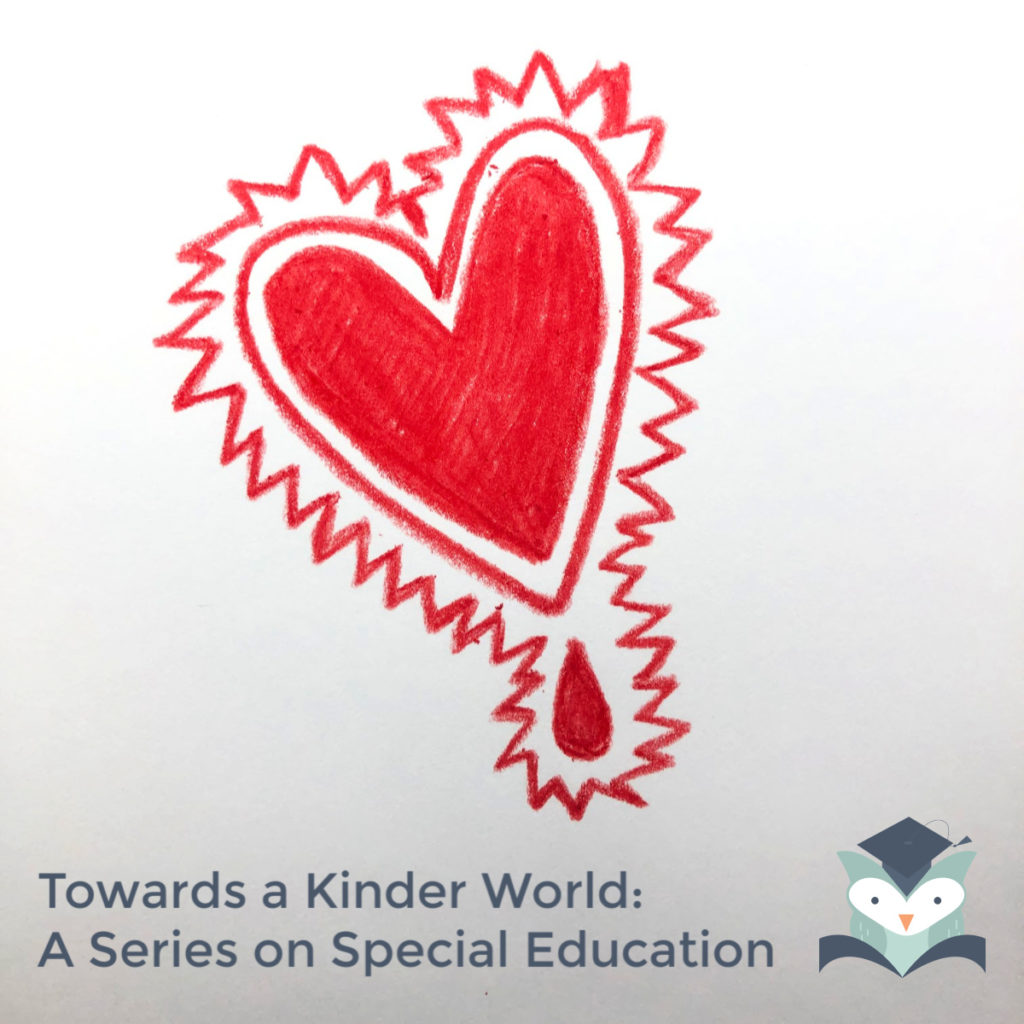
It was a gorgeous, crisp, spring morning when I sat down on Jasmin Dean’s back porch to walk through the dyslexia simulator. I had my pen ready, my Experience Dyslexia packet printed and neatly stapled. Like Dean, I grew up as a teacher’s pet. The academic work was easy for me, leaving me plenty of mental energy to spend kissing up.
Usually this dyslexia simulator would be administered in a group of your peers, she explained, to mimic the classroom environment. But I was writing this piece in the early days of COVID-19, so it was just the two of us, sitting on opposite sides of the patio, wiping things down with Clorox wipes.
That was a relief. Even as an adult, I want to impress people. I want praise, not pity. So even though I knew the test was designed to frustrate me, I wanted to at least outperform the rest of the room. So it was probably for the best that the room was empty.
Dyslexia Simulator Exercise One—Reading a Story
We began the test with a reading exercise, which required me to read familiar words constructed out of completely unfamiliar symbols, a fictional alphabet. We started with three words, our “focus words” for the exercise, similar to what you might see at the beginning of an elementary reader. As the story progressed, new words were introduced. I had to remember what each group of symbols represented, I wasn’t allowed to look back for reference.
Watching to make sure I didn’t “cheat” was Dean, playing the teacher, giving familiar, encouraging prompts to “sound it out” and “remember your strategies.”
Sound what out? I wanted to snap back. These symbols meant nothing to me.
Each halting sentence was like a memory puzzle. I tried to make myself remember the increasingly annoying groups of shapes as particular words, but there were new ones on each page. I couldn’t hold them all in my brain computer’s RAM. I struggled with the same word over and over.
My eyes started scanning the page to try to decode shapes—“okay . . . this shape was in the word ‘like’ so that’s an ‘L.’” I was reverting back to my phonics training—how I learned to read—and quickly trying to apply that to this new and unfamiliar alphabet. Phonics instruction is a game changer for dyslexic children, Dean explained later, while “whole language” instruction is a dead end. The brain can only memorize so many jumbles of nonsense.
I felt like someone hopping from wobbly stone to wobbly stone to cross a river. I was getting through it, a whoosh of relief with each remembered word, but it was neither elegant nor secure. It was not fluent. I just wanted to get through it. When Dean asked me what I remembered from the story, I had very little to offer. Ten hours later as I sat down to write this article, I remember almost nothing.
“You did really well,” Dean said, speaking not as my teacher, but as my peer now. “That was actually really good.”
Because my own education included heavy phonics reinforcement (orthography) from kindergarten through eighth grade, I had been able to start decoding in reverse by the end of the story, to create order from nonsense. If someone had taught me what each of these new symbols meant (phonics) from the beginning, it would not have been nonsense at all.
Without phonics for the new alphabet, it was up to my memory to get me started. If I had been able to practice more, I could probably have memorized most of the words in this short story, and faked a good bit of the decoding. That’s how some dyslexic readers get by in the early years. They aren’t learning to read, as much as they are employing their above average and high IQs to memorize and scavenge for clues on the spot. They are working really hard, like their teachers recommend, but all that intelligence and hard work is going toward completing assignments from scratch, not fluency. So they seem to be perpetually struggling to “get it.”
Struggling . . . out loud . . . in front of peers, Dean pointed out, is miserable.
Dyslexia Simulator Exercise Two—Write What I Say
The next dyslexia simulator exercise involved copying down words and numbers dictated by a teacher, but with other voices saying similar words and numbers at the same time. The words were all tide pool creatures, anemones, limpets and such.
I called on another skill set—years of taking quotes as a reporter—and my general familiarity with tide pool wildlife (hello, bizarre ways that privilege helps us) to get through it.
Even with those advantages, this was by far the most frustrating exercise for me. My brain was straining to focus on the one voice I needed to hear. I wanted to yell at the other voices to shut up. It felt unfair. If someone had asked me a question to answer on the spot, I’m sure I would have answered rudely or abruptly.
“No one can focus like this,” I complained, internally defending the blank spaces where I had missed words and numbers. Taking time to think that thought caused me to miss another word. Finding the word amid the jumbled sound allowed limited room for processing or committing anything to memory.
Because dyslexia affects the connections between sounds and symbols, writing what you hear is really hard. Which makes it harder to connect to the meaning, or logical flow of what is being said.
This is why it’s common on a dyslexia IEP to see certain seating arrangements, or strategies to eliminate distraction. It’s why we need to be patient with students who have short fuses with their chatty or disruptive classmates.
Dyslexia Simulator Exercise Three—Writing
If the tide pool exercise was the most frustrating, the writing exercise had me the most defeated.
For half, I covered my hand and used a mirror to trace and write shapes and numbers. For the other half, I made shapes and letters with my non-dominant hand. It was all terrible.
I watched in the mirror as my hand seemed to disobey my brain, not moving where I wanted it to go. Not moving where I knew it needed to go. The shapes of familiar numbers and letters suddenly felt illogical and foreign. Needlessly loopy. The number “5” is gratuitously complicated.
While I did this, Dean cheered me on with reminders like, “Make sure to do your best work so we can show your parents.”
I would never have wanted to show off my wobbly, messy star or my slanting, partially inverted number line.
Later, Dean pointed out that dyslexic kids often don’t want to share their work, either. They don’t want it hanging on the wall, because they know it isn’t representative of what they can do, or what they understand. It presents them to the world as less competent than they really are. Teachers who understand this can give dyslexic kids the time and tools they need to produce work they are proud of, which will keep them engaged.
Dyslexia Simulator Exercise Four—Reading Again . . . Screw This
That’s how I felt when I saw the text I was to read next. After a brief review of the “bumps and lines” letters (b, d, p, and q), I looked down at a low-res text with jumbled “bumps and lines” written right to left. The printing was spotty and worn-looking, similar to what I’ve seen in numerous classrooms where photocopies of text are used instead of books. Words cut off at the edge of the page add to the chaos students with dyslexia are trying to decode.
For readers doing their best to use the few workable “strategies” at their disposal, low quality printing is an unnecessary barrier.
This was the point when I just wanted to throw the packet on the floor. I didn’t like the way my voice sounded when I stumbled on words. I felt dumb looking up at Dean to see if I had gotten it right. I read words with the upward lilt of a question, like I couldn’t see what was in front of me. My brain was so tired. We’d only been at this for about 45 min at this point, and I knew it was a simulation designed to frustrate me. But I’m not used to struggling so obviously.
Neither are children with dyslexia, Dean said. Because reading and decoding language is a discrete skill, carried out by unique interactions in the left and right hemispheres of our brains, it’s possible that many students have excelled in most other parts of their life.
I wanted to say “screw this” and get up and walk off. Meanwhile, Dean chirped encouragements that were only making it worse.
She kept telling me that when we were done, we could go to recess. I have no desire to go to recess, but just her suggestion that I should get to the end of the paragraph made me lose valuable focus. If I had wanted to go to recess, and had felt that all my classmates were waiting on me? I’d have flipped. I’d have gone to the bathroom, faked a stomach ache, gotten a real stomach ache . . . or, if I’d have been at it for hours, days, weeks, and years, I might have just said “Screw this!” out loud, knowing that would get me sent out of class.
We ended our dyslexia simulator exercises with a fascinating spelling test that simulated hearing loss, which also mimics the way parts of words get lost in the decoding process, or drown out by other noises. By that time, I had pretty much given up. I wasn’t really trying to excel anymore. I just gave it what little effort my brain had left, performing miserably. Why even try?
That’s a survival skill. Giving up on certain tasks is a way to ration the “sh–s” you have to give, because you might need some of them to chase down your prey later.
The simulator didn’t make me feel badly for students with dyslexia. It made me admire them for their tenacity just to keep coming to school, and it made me want to rethink all that we, as a society, are putting them through.
Charter Moms Chats
Watch Inga Cotton’s interview with Bekah McNeel on Charter Moms Chats.
About the Author
Bekah McNeel is a San Antonio-based education writer who focuses on equity, innovation, and social-emotional learning for publications such as The 74. Over the years, we have republished local education coverage from her Hall Monitor site, and last November she wrote for us a four-part series, “Punished, Not Served,” about unfair discipline for students with disabilities.
Read More
- “Celebrate Dyslexia: Education, Identification, and Celebration of Dyslexic Students,” Bekah McNeel, San Antonio Charter Moms, June 10, 2020
- “What Special Education Parents Want to Keep From COVID-19,” Bekah McNeel, San Antonio Charter Moms, May 27, 2020
- “MTSS: Behavior Support That Comes Before Special Education,” Bekah McNeel, San Antonio Charter Moms, May 13, 2020
- “Decoding the IEP: Parents Learn From a Special Education Advocate,” Bekah McNeel, San Antonio Charter Moms, April 22, 2020

